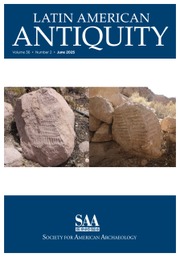Article contents
Tiwanaku Settlement System: The Integration of Nested Hierarchies in the Lower Tiwanaku Valley
Published online by Cambridge University Press: 20 January 2017
Abstract
This study reports on changing settlement patterns in the lower Tiwanaku Valley during the Formative (1500 B. C.-A. D. 100), Classic (A. D. 400-800), and Postclassic (A. D. 800-1100) periods. Based on the association of agricultural features with these site distributions, as well as the consideration of ethnohistoric and ethnographic information, it is argued that fundamental principles of the political and economic organization of the Aymara ayllus and markas can be inferred from the archaeological evidence. It also is suggested that Tiwanaku articulated local elites through mechanisms of reciprocity and common ideological denominators rather than through direct intervention and control of local sociopolitical hierarchies.
El presente estudio enfoca cambios en los patrones de asentamiento que acontecieron en el Valle Bajo de Tiwanaku durante los períodos Formativo (1500 a. C.-100 d. C.), Clásico (400-800 d. C), y Postclásico (800-1100 d. C.). Con base en la relación que guardan estos sitios con distintos paisajes agrícolas (e. g., camellones, terrazas, y qochas) y la consideración de datos etnohistóricos y etnográficos, se desarolla un modelo de "jerarquías inclusivas" para explicar la naturaleza segmentaria de la organización social Tiwanaku. Se arguye que principios similares a los que presentan la organización política y económica de los ayllus y las markas aymaras pueden ser inferidos a través de la evidencia arqueológica. Las evidencias apuntan hacia la articulación de élites locales mediante mecanismos de reciprocidad y denominadores comunes ideológicos y no así hacia una intervención directa de las jerarquías sociopolíticas locales. Los ejemplos etnohistóricos y etnográficos del ayllu y de la marka son utilizados como parámetros de interpretación de los principios de organización que caracterizaron a Tiwanaku, no así como estructuras fijas que puedan ser directamente proyectadas hacia la sociedad prehispánica.
Information
- Type
- Articles
- Information
- Copyright
- Copyright © Society for American Archaeology 1996
References
References Cited
- 50
- Cited by

